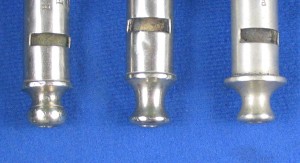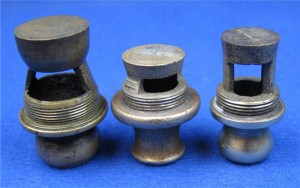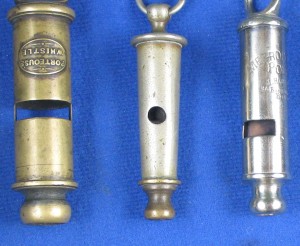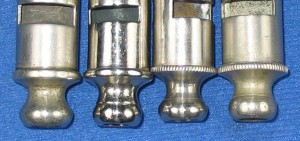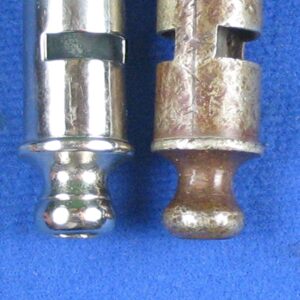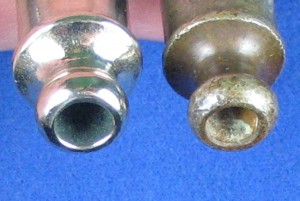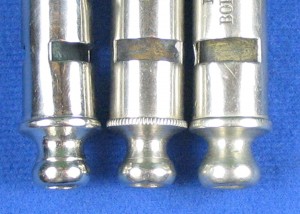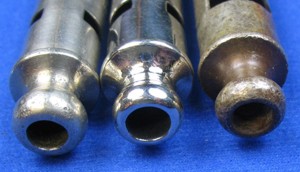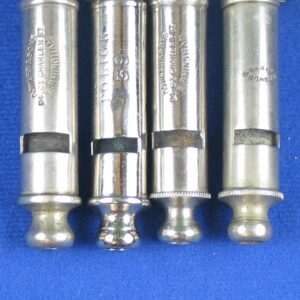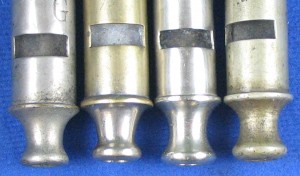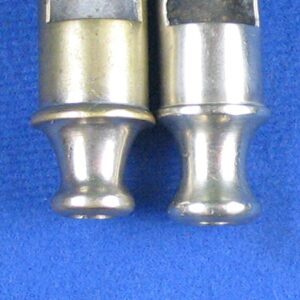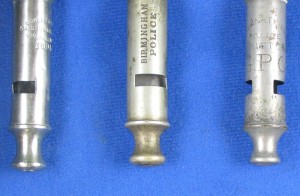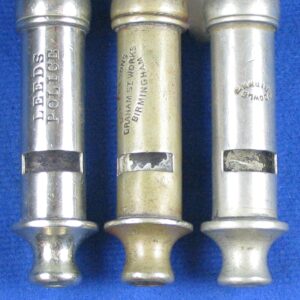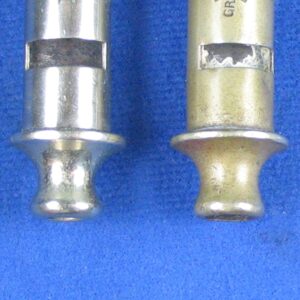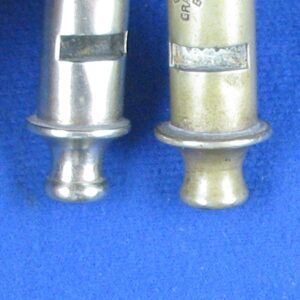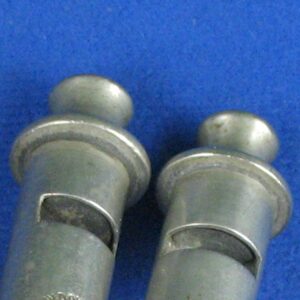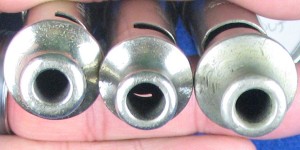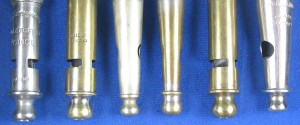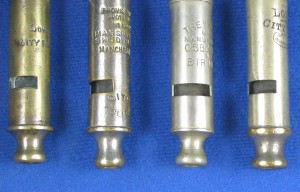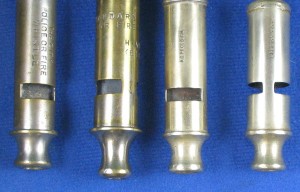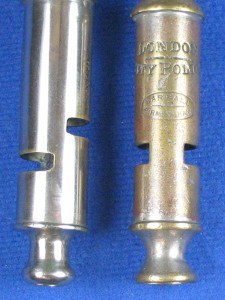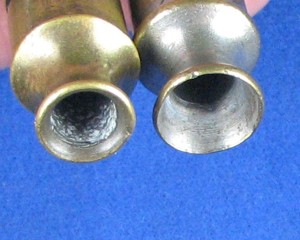Spotlight > Specific Manufacturer > United Kingdom > Dowler > 041
This SPOTLIGHT is on focused on cast mouthpieces on tube shaped whistles made by Dowler and Sons from 1886 to 1904, in England. We will look at three basic Dowler types.
- early type A round cast mouthpieces
- middle type B long hourglass cast mouthpieces
- late type C heavy, wide cast mouthpieces
This first study and classification will be staying within the country of English whistles. However other countries manufactured cast mouthpieces on tube shaped whistles such as Germany, France, America, China etc.
In giving special attention to this era of cast mouthpieces it comes to light just how many manufacturers used them and for how long many did or did not. For example several used them for the entirety of their company’s history ( e.g. Dowler, Barrall, Ward, Walton, Coney, Stevens, Yates, Hawksley ) whereas some stopped at some point ( e.g. Hudson, DeCourcy, Bent and Parker )
This examination starts with a very round short mouthpiece ( MP ), next a long hourglass MP, lastly a very wide thick MP and serves to set a benchmark for all cast mouthpieces for whistles of the time period, before and after. Why is that ?
The earliest known round cast MPs were used on tube shaped designs by Richard Porteous ( manufactured at some point by Stevens ) then came beauforts and tube shaped whistles which were manufactured by Thomas Yates, and later on both types by Joseph Hudson on whistles probably manufactured at St Mark’s street.
All four manufacturers/designers were from England. However it was William Dowler ( and sons ) that developed this concept further than anyone else, limiting all his whistles to cast mouthpieces typified by three major variations over an 18 year period.
( Exceptional whistles for tube shaped whistles with varying mouthpieces have come to light made by Lilly — pre Dowler )
Richard Porteous designed and at some point with Stevens and Sons preceded these earliest type round cast designs by mouthpieces actually incorporating the diaphragm as one larger unit (C. 1850 – 1870 ). It was not a far jump to using a separate disc attached to the partition and then being able to cast the mouthpiece seperately.
A very early beaufort by Yates with a round cast mouthpiece would indicate a date as early as 1870 (s ).
Beyond this some variable MPs probably by B Lilly and sons ( circa 1870-80 ) have surfaced. Classifying of course becomes fluid as these arise. However we are concentrating on three types by Dowler.
Joseph Hudson would have been able to produce a round cast mouthpiece for his early police whistles just prior to 1880.
Indeed, Stevens and Sons themselves stopped using the screw-in design and went to the simpler cast mouthpieces ( soldered on with no threads ) circa 1870-80, close to the time that Hudson appeared on the scene. Only Hudson ( later Dowler ) appears to have used the type A cast mouthpiece with the very rounded design, Dowler however developed it further than others. Later, Hawksley would be similar, as well as Barrall ( Hawksley had only one GSW model and Barrall had several beauforts and only two known GSW model utilizing ones close to this type MP ). By 1885 Hudson had ceased using cast mouthpieces on his simple tube shaped whistles. It was at this time that Dowler emerged as a whistle maker and began producing whistles with cast mouthpieces ( 1886 )
So we see an early transition period ( on page 58 of CPWs by Gilchrist Stevens and More Whistles page 60 ) of whistles that are seen with unscrewable mouthpieces that have very rounded MPs, but even more rounded than what Dowler would use and then changing to more hourglass shaped MPs as Dowler would during their middle period of whistle production. These Stevens were very high quality manufactured MPs originally, but by the late 19th century they had transitioned to less expensive means, no threads, and soldered on MPs.
Here is a very general timeline for English based cast round mouthpieces. It is general because the dates are based on their business records, but also on the designs of the internal parts compared to other known and substantiated design developments. This list is limited to and only for comparison of cast mouthpieces made during the length of each manufacturers business. For example Hudson has existed from 1870s to present, but made cast mouthpieces for tube shaped whistles for approximately the first 5 years.
1) Porteous —————————- 1850-1880
2) Yates ——————————— 1870-1880
3) Hudson —————————— 1880-1884
4) Dowler ——————————- 1886-1904
5) Barrall ——————————– 1886—1898
6) Walton ——————————- 1888 – 1898
7) DeCourcy —————————- 1888 – 1905
8) Coney ———————————1900 ??
9) Bent and Parker ——————–1880 –1900
10) Ward ——————————–1889 –1908
11) Hawksley —————————1890??
*** business dates based mostly from records researched by Martyn Gilchrist in CPWs ( 1998 )
However, it is Dowler that really developed these early very round shaped cast mouthpieces and produced them for the police and general market on tube shaped whistles.
In partial summary, who made them first ?? With what is known at this point in whistle research, Richard Porteous certainly designed them first. It is not known who first manufactured them for him, but at some point Stevens did manufacture them and eventually took over. Yates came second. ( Somewgere in the mix is Lilly ) Later Joseph Hudson was making them, perhaps at the St Mark’s street address. He was trained at Bent and Parker who used smaller cast mouthpieces when they started manufacturing. .
Very early Hudson made Manchester police whistles and other very early GSWs similar to Dowler type A mouthpieces have surfaced possibly preceding the move to 84 Bucks street in 1882-3. Hudson stopped using them as soon as he possibly could by 1885 ( except for large King beauforts and large ‘Porteous’ top whistles ).
Dowler existed as a company prior to starting manufacturing whistles in 1886 . Apparently as Hudson ceased using cast mouthpieces, Dowler started up and went on to use them, and with greater physical characteristics —- during this same general period — circa 1886 to 1904
The periods used correspond to the two manufacturing locations of:
- 94 Charles street – 1886-1900
- Graham street – 1901-04
Dowler and sons abandoned whistle manufacturing after this. However, for apparently 18 years Dowler and Sons manufactured tube shaped whistles with cast mouthpieces. – type A, type B, type C.
After they stopped making their own whistles ( 1904 ), they subcontracted to Hudson’s and DeCourcy’s companies to make their whistles, even having them use their own stamps and perhaps parts, circa 1904. Hudson was still located at 13 Barr street and DeCourcy moved to Frankfort street that same year.
At this point during this time period, Dowler stamped whistles appear on the scene — with ‘rolled’ mouthpieces, manufactured by Hudson and DeCourcy (although we do have a Hudson made whistle for Dowler with a cast mouthpiece). Rolled mouthpieces had become the norm mid-way through the first decade of 1900, as it had become mainly Hudson and DeCourcy producing whistles at that time and they manufactured exclusively rolled or machined mouthpieces. For them ( with exceptions ), handmade cast mouthpieces for tube shaped whistles had become a thing of the past.
Aside from using up parts from the Dowler storehouse of leftovers, this becomes a useable difference to look for when differentiating who manufactured a whistle stamped Dowler. Thereafter one needs to separate Hudson from DeCourcy, easily done by looking inside the whistles.
As a rolled mouthpiece is machine made and the open part rolled inwards, it is easily identified. Prior to this would be cast mouthpieces taking much more work to manufacture and showing quite a bit of variability, even roughness. The sizes varied as well as the shape. Beyond this the openings could vary. Some had lines or grooves around them to dress them up, there also might be milling added to the edge. No lines or millings have been seen on type B Dowler mouthpieces.
Brass type A mouthpieces can be found on Hawksley and Barrall whistles. We are still looking for a brass whistle with a cast type A mouthpiece on a Dowler, but as of now all are nickel silver. They date from the 1880s to the 1890s.
From the 1890s to early 1900s, can be found both nickel silver and brass cast mouthpieces, type B on Dowler whistles. Smaller cast mouthpieces are found on Walton, Hudson, Bent and Parker and DeCourcy whistles that are very similar to each other. It is interesting to see the similarities in these particular four companies, all of which influenced each other. Joseph Hudson trained at Bent and Parker, Walton and DeCourcy trained at Hudson’s and became foremen, before leaving and starting their own businesses.
Now let’s zoom in on some examples. First a group picture of type A. From left to right we have picked 4 slightly different examples.
Our cross selection includes police and general service examples – type A ( early round cast mouthpieces )
We zoom in to see that the thickness may vary with each casting as well as the surface imperfections. This really adds character and craftsmanship to each whistle.
And for that matter notice the openings are also subject to a range, perhaps affecting the sound. Look at the thickness of the HEREFORD police on the left, quite a heavy whistle.
Then compare to a plain surface one. They have the feel every time of custom made products.
Now a closer look at three openings on several, each having its own characteristics.
If milling is added it makes the whistle feel and look even more rich.
Moving on we now examine type B ( middle era cast MPs )
This period is shaping MPs that will look more like machined rolled ones in an ‘ hour glass’ fashion.. However they are also cast. During this period several other makers were also making type A cast mouthpieces such as Ward, Bent and Parker, Coney, and Barrall, although of various smaller shapes.
Walton went out of business just before 1900 and DeCourcy stopped using cast mouthpieces altogether turn of the century or at latest 1904. Hudson stopped using cast mouthpieces in 1885 –except for Kings, and Porteous top tube shaped whistles.
Dowler type B mouthpieces are unique in their length and shape to Dowler. The closest ones being Barrall whistles, but so much variability and roughness lent to only occasional matches. Indeed Barrall mouthpieces are almost as distinct as Dowler. They are usually shorter and thinner.
Typical of Dowler’s type B is the third from left whistle MP shown here in the group picture and left to right are variations one may encounter. They are longer than usually seen in cast mouthpieces. The second from left is unique to Dowler and is seen on circa 1900 INTERNATIONAL and KNOXALL stamped whistles. The far left is a rare GPO by Dowler also circa 1900 and looks close to the far right shape. By far, three are very typical of type B with a long curved hourglass design. By looking inside the mouthpiece you can easily see that it is cast.
Lengths can vary slightly in these longer than usual cast mouthpieces.
Note how the windows only approximately match and the mouthpieces vary with different lengths ??
Brass on the, left and nickel silver on the right.
And the openings are proportionately different…
The next progression incorporates the protruding connection of the partition to the disc inside for a scale of change over a ten year period matching type B .
Nothing is set in stone here, but the earliest ( 1894 ) has no protrusion through the disc. The middle two have typically smoothed off protrusions and the last two have protrusions that stand tall through the discs.
See CPW for protrusions through the disc page 92.
Now, paralleling this later period are cast mouthpieces that are heavier and wider found almost exclusively on Dowler whistles on their ‘Porteous’ top whistles – type C. ( Hudson used the same type MPs on some of their Porteous top whistles.
Note they are slightly shorter and the flat part that attaches to the tube is wider and thicker. Designated for type C, these are always cast.
Only rarely is a ring seen as follows…
The thickness of the attachment may vary as well as the openings again due to the variability of casting.
And the openings have a range, as they are fashioned by hand
Following are some comparisons of other cast mouthpieces that parallel Dowler’s existence:
These all fall within the general timeline created above.
Left to right in following picture:
Hudson Porteous – c 1910
Hawksley – c 1890
Barrall beaufort – c 1890
Barrall beaufort – c 1890
Barrall GSW – c 1890
Hudson King – c 1890
Left to right in following picture:
DeCourcy – c 1895
Walton – c 1890
Bent and Parker – c 1883
Barrall – c 1890
Left to right in following picture:
Yates – c 1880
Ward – c 1890
Ward – c 1890
Stevens – c 1880-90
Also left to right in the last two :
Coney – c 1900
Barrall – c 1890
Barrall openings showing the variety within cast mouthpiece works.
What conclusions can we draw at this juncture ??
1) Dowler manufactured three types of mouthpieces
a) cast round
b) cast hour glass
c) cast heavy larger for Porteous whistles
2) Dowler cast mouthpieces can be used to identify their whistles
3) Dowler used only cast mouthpieces
4) Dowler stamped whistles with machine rolled mouthpieces were made by ‘others’ ( i.e. Hudson,
DeCourcy )
5) Dowler’s use of cast MPs progressed from type A to type B to type C
6) Richard Porteous probably designed the earliest type A cast mouthpieces for tube shaped whistles and they screwed together. He set the standard that Dowler later developed further.
7) At least Yates, Stevens and Hudson ( perhaps Lilly ) predated Dowler with cast MPs ( large rounded type A )
8) Many others also used cast MPs and most for the entirety of their company’s history.
9) Bent and Parker used cast MPs prior to Dowler and influenced Hudson, DeCourcy and Walton ( three of which smaller cast MPs look very similar )
This examination has been an eye opening experience and we hope you too have benefitted. Identification is always suspect, but the more that is known and understood the better equipped we are to classify what we find.
Hats off to William Dowler and Sons for adding to the whistle world.
As always, any errata spotted will be promptly amended. Please feel free to write in.
TWG
Posted February 5, 2015
